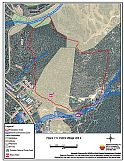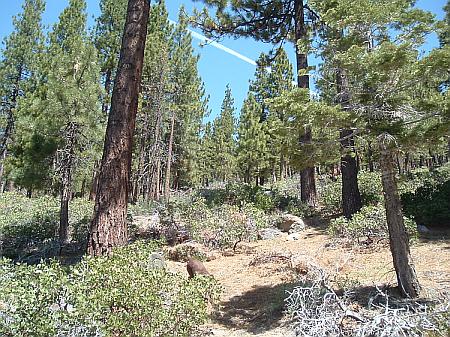Risk/Hazard Identification and Mitigation Project Worksheet
Name of Community: Incline Village
Date: July, 2004
Project Title: Incline Village Unit 2 - Thinning and Brush Removal; Fuelbreak
Description of Risk/Hazard: Describe in detail the risk or hazard that poses a threat to the community.
Vegetative Fuel and Topography: The Incline Village Unit 2 is characterized by an open stand of Jeffery pine with a heavy brush (up to 5’ tall) understory. The brush is dense and forms a continuous fuel bed across a S-SW facing slope. The north slope is a dense mixed conifer stand of Jeffery pine, white fir, and incense cedar stocked at an estimated 120 square feet of basal area per acre and up.
Worst Case Scenario / Hazard: With the wind blowing upslope off of the lake, a human-caused ignition from the road or the development to the south would quickly spread into this area. This wind-driven fire would develop a large flame front threatening residences from County Club Drive to the ski resort. Should suppression fail at the ski resort, the flame front would move directly to Tyrolian Village. Burning embers from the flame front in this proposed treatment would easily reach Tyrolian Village under worst case conditions. Fire behavior would be extreme and uncontrollable.
Priority Ranking: What is the priority ranking of this risk/hazard in relation to all others identified?
This project ranks as the #3 priority to reduce risk/hazard potential in the NLTFPD. Potential fire behavior is extreme, with a wind driven fire moving uphill in dense fuels towards commercial properties and residential structures. The project can be broken into two phases, the perimeter touching the community and the interior. The perimeter element would be a high priority, the interior could be a moderate priority. Should the interior remain untreated, the treatment around the perimeter would have to be more aggressive to be effective.
Location: Describe or attach a map with sufficient detail to allow accurate ground location.
West side of Incline Village, just south of Diamond Peak Ski Area. See Figure 7-3.
Recommended Mitigation Measures and Scope of Work: Present prescription and work specifications in sufficient detail to facilitate procurement of bids and quotes. For hazardous fuel removal projects include estimated volumes (tons/acre) of fuel removed and disposal plan.
Remove or thin brush understory to decrease the fire intensity and reduce ladder fuels. Spacing between remaining bushes should be 2-3 times the height of brush. A brush masticator could be used where slopes are 30% or less, though few areas have slopes less than 30% in this prescription area. Grind the brush and leave as mulch, or hand cut, pile, and burn. Use of herbicide could reduce sprouting of some species.
Create a fuel break 300 feet wide along the north slope of the prescription area that borders the road to the ski resort. Thin from below, removing smaller trees and leaving larger ones to achieve the desired stocking rate of 80 to 100 square feet of basal area per acre.
*Prescribed fire could be used to reduce the brush understory, and desired where feasible to return fire to the landscape. It should only be applied in areas after thinning and slash pile burning are complete to maintain fire control within five years of pile burning.
Evaluation of the Extent to Which Completion of This Project Will Reduce the Fire Threat:
This will help prevent a wildfire from moving into the SE part of Incline Village. Treatment in this area will help contain human-caused ignitions below the project area, keeping fire from spreading uphill towards Lower Tyrolian Village and becoming uncontrollable. It will also protect the private and commercial structures from a downslope fire event. Implementation of the prescription will reduce the competition among residual trees, increasing forest health and decreasing tree mortality. This will decrease the accumulation of dead and down material contributing to the fuel loadings on the forest floor.
If all of the recommendations in this report are implemented, there is still no guarantee that a devastating wildfire will not occur in the Incline area. However, community awareness and individual attention to fuels management on private property and fuel reduction on state, federal, and county property will help to achieve the highest level of wildfire safety possible.
Identification of Protected Species or Other Critical Resources: Describe any measures that must be taken to protect critical wildlife habitat, historic
Environmental compliance measures must be implemented before project initiation. Stream Environment Zones are located in the project area and must be protected, employing appropriate TRPA mitigation measures.
Some threatened and endangered species exist in the Tahoe Basin. Appropriate avoidance and mitigation measures should be employed during project implementation.
Compliance with cultural resource protection may also be necessary. Check with TRPA and the NVSHPO to ensure cultural resources are protected.
Estimated Timeline:
Desirable time of year to complete:
April - December: Burning should occur during a period of cooler temperatures and moderate moisture (late fall) to allow for the best fuel consumption versus fire controllability ratio. Thinning and hand work could occur anytime conditions are dry enough to minimize soil disturbance, but preferably outside of extreme fire condition season. The south slope can be burned in late fall to achieve the desired results. The north slope could be thinned in two months. A cable yarder could remove most of material, or slash could be burned in the fall.
Estimated time required to complete project:
Depending on available resources the project could be completed in a 12-month timeframe (one fall to the next)
Post-project Rehabilitation: Present scope of work in sufficient detail to facilitate procurement of bids and quotes.
Rehabilitate any fire control lines, landings or disturbed areas. Rehabilitation will be minimal if only hand methods are used. Where soil has been disturbed, TRPA rehabilitation measures and Best Management Practices would apply. This could include reseeding or mulching areas if necessary.
Other Considerations: Describe any other considerations that must be taken into account to successfully complete this project such as permits, clearances, approvals, etc.
The NLTFPD should conduct a public education campaign to inform residents and businesses in the area of proposed actions and desired effects.
- TRPA - Permit
- NDF - Harvest Permit (N. slope)
- NDF - Prescribed burn permit
- Air Quality Permit (Washoe County)
Estimated Cost: Present an estimate of the total cost of project completion and the basis for the estimate presented. If the project can be subdivided into phases or various components, present an estimated cost for each.
Cable yarding is recommended, however, no costs for cable yarding were available. The costs below are a minimum based on currently accepted methods in the Tahoe Basin.
| Hand cut, pile, and burn | $2,000 / acre X 161 acres | |
| Total Cost | $ 322,000 |
Prescribed burn planned for Fall 2004, no biomass estimate with burning.
Project Maintenance Requirements:
Brush species will re-sprout readily, requiring frequent treatment every 5 years. Use of herbicide (Roundup painted on brush stumps) will prevent many of the shrubs from resprouting. Prescribed fire would be the preferred maintenance method every 10 years.
Figure 7-3Proposed Prescription Area Incline Village Unit 2 |
 |

